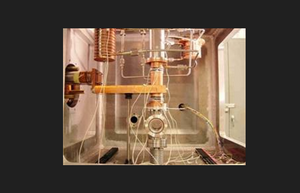ITER pellet injector produces deuterium ice
Good news from the icy front: On 11 March a team from Oak Ridge National Laboratory (ORNL) led by Larry Baylor, Steve Meitner and Steve Combs successfully produced the first deuterium ice using a twin-screw extruder. This new prototype extruder is 1/5 the size of the device that will be required for ITER, which will be capable of injecting an infinite number of pellets into the ITER plasma. It is the first step towards a pellet injector feeding particles deep inside the plasma.
The pellet injection system has two main experimental objectives: deep plasma fuelling to control plasma density and burn, and pacing of the edge instabilities called ELMs. The ITER pellet injection system is based on the gas gun technology originally developed in the US and continuous screw extruder technology originally developed in Russia. The new twin screw system developed at Oak Ridge will be capable of producing ice at a throughput of more than 100 Pa m3/sec.
Cylindrical pellets are cut from the different species of ice ribbons (hydrogen, deuterium, tritium, impurities or their mixture) by the sharp edge of thin wall tubes. Then a short pulse of propellant gas (hydrogen or deuterium up to 30 bar), accelerates each pellet up to 300 m/s. For the plasma density and burn control, pellet injection (~90 mm3 and 16 pellets per second maximum) from the high field side (inner wall) is provided by a dedicated flight tube. For the ELM control, smaller pellets at high frequency (~30 mm3, up to 40 pellets per second) are delivered through a low field side (outer wall) flight tube.
Two pellet injectors will be installed as the start-up machine configuration for hydrogen operation. There will be a provision to upgrade the system to a six injector configuration for DT plasma operation. The next step will be developing a pneumatic gas gun capable of accelerating the pellets to a speed of 300 m/s to allow it to penetrate deep into the plasma and — in a further step - to mate it with the extruder to form the pellet injector.


